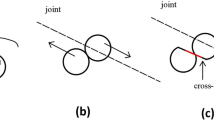Abstract
A modified discontinuous deformation analysis (DDA) algorithm was proposed to simulate the failure behavior of jointed rock. In the proposed algorithm, by using the Monte-Carlo technique, random joint network was generated in the domain of interest. Based on the joint network, the triangular DDA block system was automatically generated by adopting the advanced front method. In the process of generating blocks, numerous artificial joints came into being, and once the stress states at some artificial joints satisfy the failure criterion given beforehand, artificial joints will turn into real joints. In this way, the whole fragmentation process of rock mass can be replicated. The algorithm logic was described in detail, and several numerical examples were carried out to obtain some insight into the failure behavior of rock mass containing random joints. From the numerical results, it can be found that the crack initiates from the crack tip, the growth direction of the crack depends upon the loading and constraint conditions, and the proposed method can reproduce some complicated phenomena in the whole process of rock failure.
Similar content being viewed by others
References
WONG R H C, CHAU K T, TANG C A, LIN P. Analysis of crack coalescence in rock-like materials containing three flaws (Part I): Experimental approach [J]. International Journal of Rock Mechanics and Mining Sciences, 2001, 38(7): 909–924.
NARA Y, KANEKO K. Study of subcritical crack growth in andesite using the Double Torsion test [J]. International Journal of Rock Mechanics and Mining Sciences, 2005, 42(4): 521–530.
XIA K W, CHALIVENDRA V B, ROSAKIS A J. Observing ideal “self-similar” crack growth in experiments [J]. Engineering Fracture Mechanics, 2006, 73(18): 2748–2755.
KAMAYA M. Growth evaluation of multiple interacting surface cracks (Part I): Experiments and simulation of coalesced crack [J]. Engineering Fracture Mechanics, 2008, 75(6): 1336–1349.
HOLZHAUSEN G R, JOHNSON A M. Analysis of longitudinal splitting of uniaxially compressed rock cylinder [J]. International Journal of Rock Mechanics and Mining Sciences and Geomechanics Abstracts, 1979, 16(3): 163–177.
NEMAT-NASSER S, HORII H. Compression-induced nonlinear crack extension with application to splitting, exfoliation, rockburst [J]. Journal of Geophysical Research, 1982, 87(B8): 6805–6821.
WANG E Z, SHRIVE N G. Brittle fracture in compression: Mechanisms, models and criteria [J]. Engineering Fracture Mechanics, 1995, 52(6): 1107–1126.
BOBET A, EINSTEIN H H. Fracture coalescence in rock-type material under uniaxial and biaxial compression [J]. International Journal of Rock Mechanics and Mining Sciences, 1998, 35(7): 836–888.
WONG R H C, CHAU K T. Crack coalescence in a rock-like material containing two cracks [J]. International Journal of Rock Mechanics and Mining Sciences, 1998, 35(2): 147–164.
JIAO Y Y, FAN S C, ZHAO J. Numerical investigation of joint effect on shock wave propagation in jointed rock masses [J]. Journal of Testing and Evaluation, 2005, 33(3): 197–203.
JIAO Y Y, ZHANG X L, ZHAO J, LIU Q S. Viscous boundary of DDA for modeling stress wave propagation in jointed rock [J]. International Journal of Rock Mechanics and Mining Sciences, 2007, 44(7): 1070–1076.
GOLSHANI A, OKUI Y, ODA M, TAKEMURA T. A micromechanical model for brittle failure of rock and its relation to crack growth observed in triaxial compression tests of granite [J]. Mechanics of Materials, 2006, 38(4): 287–303.
CHARALAMBIDES P G, MCMEEKING R M. Finite element method simulation of crack propagation in a brittle microcracking solid [J]. Mechanics of Materials, 1987, 6(1): 71–87.
TAN X C, KOU S Q, LINDQVIST P A. Application of the DDM and fracture mechanics model on the simulation of rock breakage by mechanical tools [J]. Engineering Geology, 1998, 49(3): 277–284.
XU Y, SAIGAL S. An element free Galerkin formulation for stable crack growth in an elastic solid [J]. Computer Methods in Applied Mechanics and Engineering, 1998, 154(3/4): 331–343.
CHEN Wei, LI Shi-hai. Deformable and rupturable block model for 3D distinct element method [J]. Chinese Journal of Rock Mechanics and Engineering, 2004, 23(4): 545–549. (in Chinese)
JIAO Y Y, LIU Q S, LI S C. A three-dimensional numerical model for simulating deformation and failure of blocky rock structures [J]. Key Engineering Materials, 2006, 306/308: 1391–1396.
JIAO Y Y, ZHANG X L, WANG S L, WU H Z. On using discrete particle approaches for simulating perforation process of concrete slab by hard projectile [J]. Key Engineering Materials, 2007, 353/358: 2973–2976.
SHI G H. Discontinuous deformation analysis: A new numerical model for the statics and dynamics of block system [D]. Berkeley: University of California, 1988.
SÁNCHEZ S, CRIADO R, VEGA C. A generator of pseudo-random numbers sequences with a very long period [J]. Mathematical and Computer Modelling, 2005, 42(7–8): 809–816.
DENG L Y, GUO R, LIN D K J, BAI F S. Improving random number generators in the Monte-Carlo simulations via twisting and combining [J]. Computer Physics Communications, 2008, 178(6): 401–408.
UEMURA K, SAITO T. Automatic mesh generation for FEM simulation of wind flow around tall buildings [J]. Journal of Wind Engineering and Industrial Aerodynamics, 1993, 46/47: 357–362.
DENG Jian-hui. Adaptive finite element analysis of jointed rocks-method and implementation [D]. Wuhan: Institute of Rock and Soil Mechanics, Chinese Academy of Sciences, 1994. (in Chinese)
GUÉNETTE R, FORTIN A, KANE A, HÉTU J F. An adaptive remeshing strategy for viscoelastic fluid flow simulations [J]. Journal of Non-Newtonian Fluid Mechanics, 2008, 153(1): 34–45.
JIAO Yu-yong, ZHANG Xiu-li, LIU Quan-sheng, CHEN Wei-zhong. Simulation of rock crack propagation using discontinuous deformation analysis method [J]. Chinese Journal of Rock Mechanics and Engineering, 2006, 26(4): 682–691. (in Chinese)
Author information
Authors and Affiliations
Corresponding author
Additional information
Foundation item: Projects(50479071, 40672191) supported by the National Natural Science Foundation of China; Project(SKLZ0801) supported by the Independent Research Key Project of State Key Laboratory of Geomechanics and Geotechnical Engineering; Project(SKLQ001) supported by the Independent Research Frontier Exploring Project of State Key Laboratory of Geomechanics and Geotechnical Engineering
Rights and permissions
About this article
Cite this article
Zhang, Xl., Jiao, Yy. & Zhao, J. Simulation of failure process of jointed rock. J. Cent. South Univ. Technol. 15, 888–894 (2008). https://doi.org/10.1007/s11771-008-0162-0
Received:
Accepted:
Published:
Issue Date:
DOI: https://doi.org/10.1007/s11771-008-0162-0




